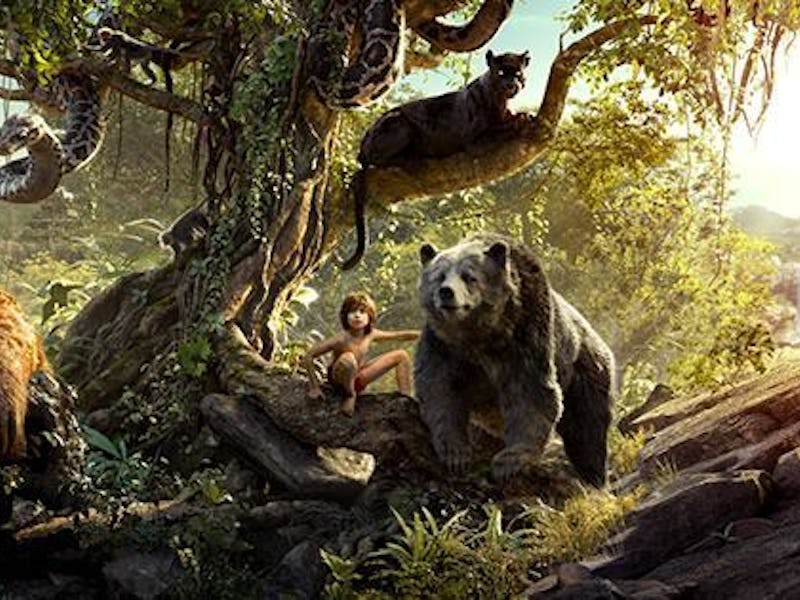Disney Doldrums: The View of Childhood Wonder in 'The Jungle Book' Remake Is Depressing
Jon Favreau's densely CGI-d remake clearly misses the spirit of its source material.

Rudyard Kipling’s 1894 collection, The Jungle Book, is something like Aesop’s Fables, with recurring characters and an occasionally dark tone. The latter aspect channels a bit of the Indian folk tales and myths from which Kipling got some of his inspiration. Like the tales of Aesop and The Brothers Grimm, Kipling’s interweaving stories are meant to set examples for children, and offer a sense of magic and adventure.
The stories have been strung together and referenced in TV and films numerous times, but the household-name example, of course, is 1967’s Disney musical version. In an interview with Variety, director Jon Favreau recalled his first impressions of the film, which set the structural and tonal template for many subsequent Disney films, including mega-hit The Lion King. “You are a kid, and the cement [of your mind] is still really wet,” he said. “You are imprinting very deeply.” Now, the once-fan is attempting to make the new classic version of Kipling’s story, referencing the Disney’s film’s additions as well as the original stories — but probably mostly the Disney film. The currently circulating trailer for the film, which is due out April 15, ends with a post-Marvel-movie-credits Easter egg of the tune to “The Bare Necessities,” the Disney movie’s most celebrated number.
But though Favreau claims to love the film, the lighter, madcap tone is not what he seems to be aiming for in his retake. By all indications, this is Kipling’s tales with a coherent origin story, in the vein of most blockbuster reboots or adaptations — from King Kong to Pan. There’s a Sturm und Drang intensity to the teaser trailer, which features an eerie voiceover from Scarlett Johansson as Kaa the snake, and images of Mowgli — possibly the only non-digitally-created thing in the clip — bounding frantically through the forest. What’s missing here is any evidence of the fun and humor of either Kipling’s stories or the ‘67 film. One has to respect Favreau — given that he is taking on this project — for trying something new with the material, but to lose the irreverent quality inherent to all the source material seems a grave loss, especially for these stories.
Favreau’s comments about the film also paint a disheartening view of what is considered alluring to children in blockbuster films these days. Sure, Pixar persists, with a once-fresh, action-packed vision that has gotten mixed results with so much reiteration; its sensibility has a lot of goofball humor, and offers an alternative to the Marvel-movie-esque style of most other movies in the multiplexes.
But Favreau’s film does certainly seem to have the self-serious air of a classic nu-comic book film, or say, The Hunger Games. In an interview with Slashfilm, Favreau was explicit: absurdity is not part of his vision.
A lot of [the movie] is adding greater adventure and peril and a greater edge and sense of danger than the musical one had, while retaining the elements that I would want to see, and want to take my kid to see.
He does claim to want comedy in the project (Christopher Walken and Bill Murray lend their voices), but with a rather curious statement, also admit that he struggles with being funny:
That was the lesson in Iron Man, you know. On Elf there were notes about every joke, on Iron Man nobody gave me any notes on jokes but everybody would give me notes about every action sequence. On Elf nobody gave me any notes on the action sequences. So it’s like, if you want to do comedy, you’re better off doing an action movie. Nobody to give you a hard time! And if you get a laugh it’s a bonus. In a comedy if you’re not getting laughs every ten seconds, you’re failing.
But, of course, another favorite part for Favreau is creating the phantasmagoria. The “sense of danger” comes from being able “to use all these toys. That’s the nice part about the big [movies]. Whatever technology has to offer you have access to, and how could you best tell a story with those tools.”
The trick to getting through to kids, for Favreau, is to overwhelm them: make a big-budget, glitzy spectacle that can get lost in. It seems not only a strange way to treat source material as diverse and unique as The Jungle Book, but to represent a certain, regrettable, homogenizing school of thought in blockbuster filmmaking. Visceral awe is the goal. Dramatic realism, even when dealing with talking animals, and fast-paced sleight of hand is the only way to keep their attentions. Projects like The Jungle Book — and most youth-friendly action-adventure franchises — pack their points of inspiration into packages that, if you take a step back from them, are very similar in tone, structure, and aesthetic. One might have hoped for something better for The Jungle Book.
Care to see if Favreau’s movie actually manages to pack some surprises? You can catch it in multiplexes everywhere on April 15.